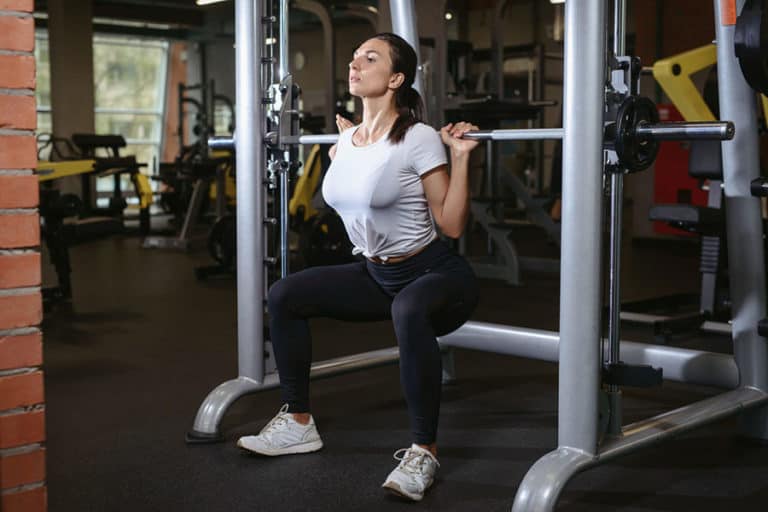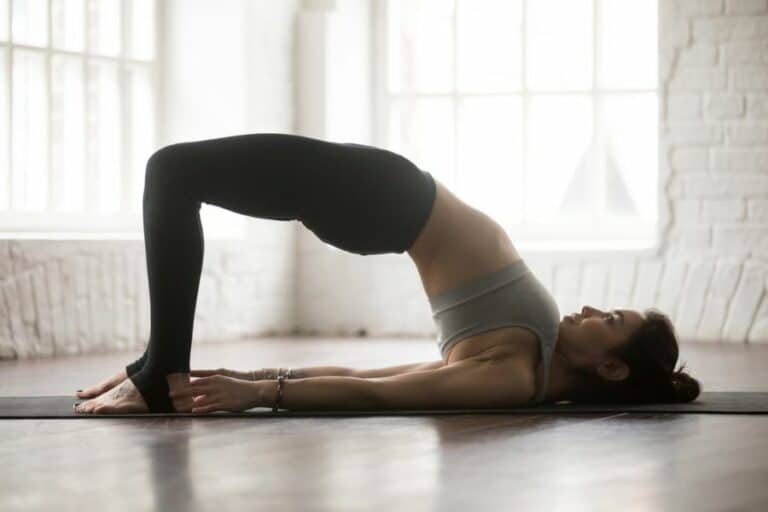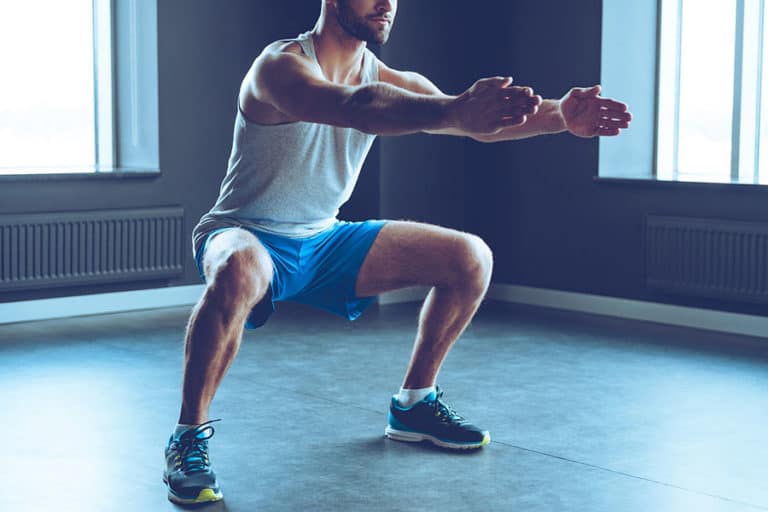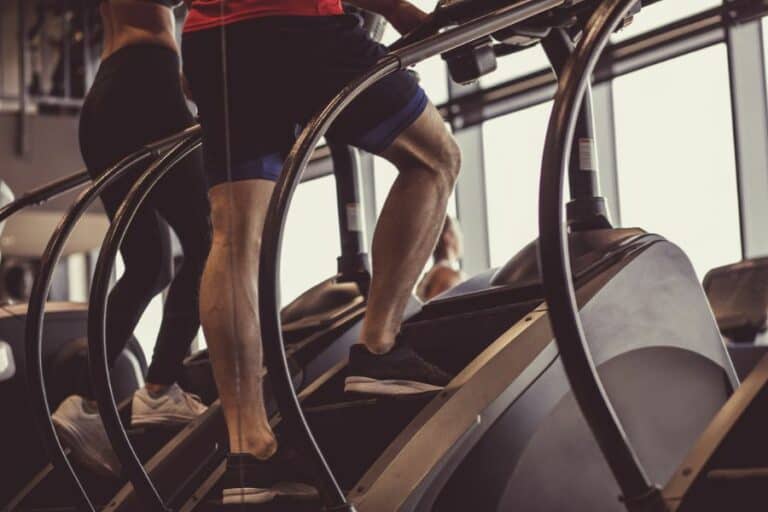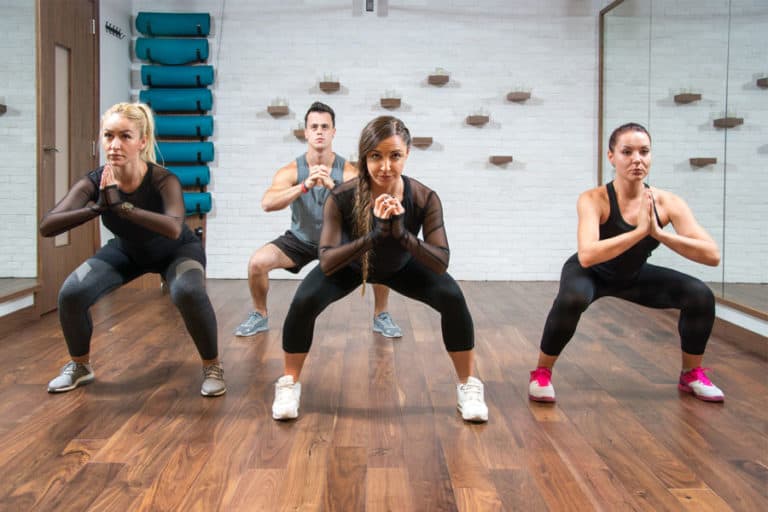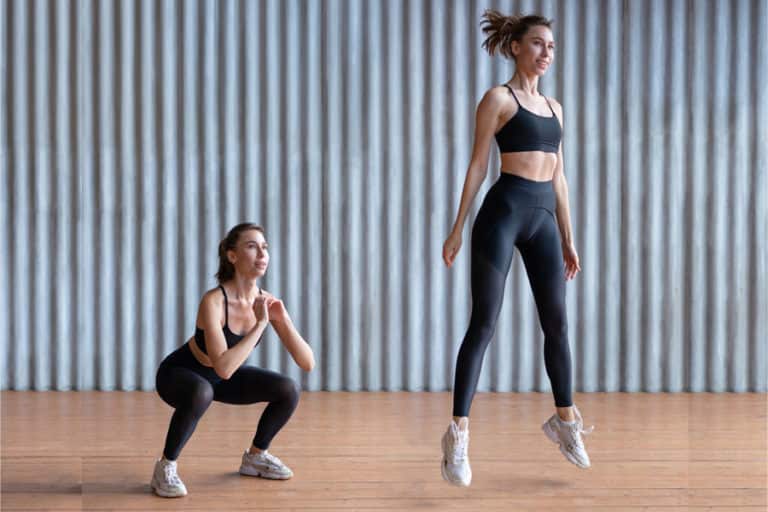How Many Squats Should I Do a Day?
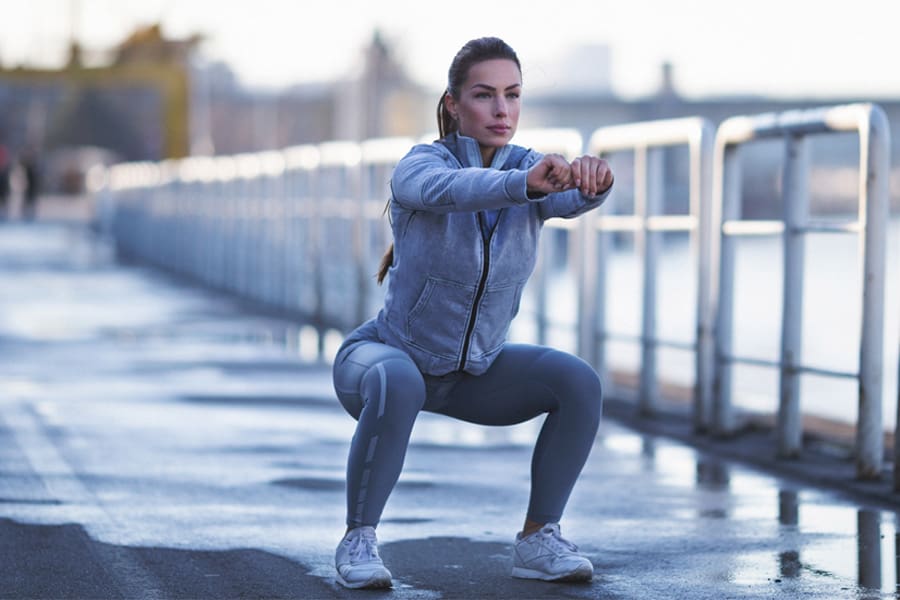
How many squats | Squat types | Benefits | Risk factors
Squats are a classic, lower-body strength-building, compound exercise. The benefits of this exercise extend from your leg region to your core and even the back muscles. It is also great for improving functional strength.
How many squats should I do a day?
The answer to this question depends on factors such as your fitness level, goals, age, health conditions, and how much time you dedicate to working out in general.
Read on to understand what factors determine the number of squats you should do in a day:
1. Fitness levels
If you are new to squatting, you may not have the required stamina to push 100 squats on the first day of your squat workout. Start with fewer sets and reps and gradually increase as you get stronger.
Here’s a table that shows the number of sets and reps to be performed by people of different fitness levels:
| Fitness level | Squat Type – Sets and Reps |
| Beginner level | Basic Squat – 3 – 5 sets of 8-12 reps Jump Squat – 3 – 4 sets of 10 – 15 reps Wall Squat – 2 – 3 sets of 5 reps with 20 seconds holding the pose Pulse Squat – 3 – 5 sets of 8 – 15 reps (3 pulses each) Frog Squat – 2 – 3 sets of 10 – 15 reps Sumo Squat – 2 – 3 sets of 6- 8 reps Box Squat – 3 – 4 sets of 10-12 reps |
| Intermediate level | Goblet Squat – 4 – 5 sets of 15 – 20 reps Pistol Squat – 2 – 3 sets of 10 – 15 reps on each side Cossack Squat – 5 – 7 sets of 8 – 10 reps on each side |
| Advanced level | Front Squat – 3 – 5 sets of 10 – 12 reps Back Squat – 3 – 5 sets of 12 – 15 reps Overhead Squat – 3 – 6 sets of 8 – 10 reps |
2. Fitness goals
Do you want to lose weight, build lower body muscle, or simply improve stamina or functional strength? Your fitness goals will determine the number of reps, the type of squats you choose, and the type of weights you add to your squat workout.
In certain cases, the number of reps may not be as significant a factor as the squat stance or depth.
For instance, people who wish to target the glute muscles might benefit from increasing their squat depth [1]The Journal of Strength and Conditioning Research: The Effect of Back Squat Depth on the EMG Activity of 4 Superficial Hip and Thigh Muscles rather than reps. If you are trying to bulk up or gain muscle, you’ll need to add more weight to your existing squat workout. Take a look at the table below:
| Goal | Squat type | Sets/Reps |
| Improve form and strength | Basic bodyweight squats | 2-5 sets of 5-10 reps |
| Hypertrophy | Weighted squats (depending on your fitness levels) | 3-5 sets of 10-15 reps |
| Weight Loss | Weighted squats (depending on your fitness levels) | 8-10 sets of 25-50 reps (only with the help of a calorie deficit through diet) |
Note: The numbers and expected results may vary due to differences in physical conditions, age, gender and dietary patterns.
3. Type and intensity of your squats
Each type of squat demands a different number of reps. For instance, a basic squat or wall squat can be done for 30-50 reps, whereas a goblet squat or barbell back squat may need only 10-15 reps.
The intensity of your squats also matters. Doing 20 bodyweight squats at a slower pace will be easier than doing 10 squats with added weight and fewer pauses. The table below can help you get a perspective on how an increase in weights changes the ideal number of reps:
| Type of squat | Reps you can do |
| Basic squat | 5-10 sets of 30-50 reps |
| Goblet squat | 2-4 sets of 10-15 reps |
| Barbell box squat | 2-4 sets of 10-12 reps |
4. Your age and health conditions
There is no definitive answer to how many squats you should do at your age. Each body is unique and has different limitations and requirements.
If you are older, have health conditions that limit your mobility, or are just starting to work out, you may want to do fewer squats. On the other hand, if you are younger, have no limiting health conditions, and are already used to working out, you can do more squats.
A good fitness trainer can guide you better by considering your age, physical challenges, and stamina.
5 types of squats
Add the below mentioned 5 types of squats to your workout routine to reap the benefits of a good lower body workout. You can modify the intensity levels of these exercises according to your fitness levels and needs.
1. Basic squat
The basic squat is performed by bending at the knees and lowering the hips until your thighs are parallel to the ground. This exercise is a versatile addition to any lower-body workout and can be performed with or without weights.
In addition to working the muscles of the legs, basic squats also help to improve hip and knee mobility.
2. Sumo squat
The sumo squat is a great exercise for targeting the inner thigh muscles, also known as the adductors. When you lower your hips in a sumo squat, you should feel a stretch in your inner thighs as you engage those adductors.
Apart from the adductor muscles, this exercise also works the calf muscles, hamstrings, and glutes.
3. Curtsy Lunge
The curtsy lunge, also known as curtsy squat is a simple exercise that involves bending at your knees while moving one leg behind and across the other. This movement helps to tone and tighten the muscles of your inner thighs, hips, and glutes.
4. Pistol squat
The pistol squat is a slightly more advanced exercise that requires significant strength and balance. This move is performed by lowering your body towards the ground on one leg while keeping the other leg extended out.
This exercise targets the leg, hip, and glute muscles. It also contributes to the balance and coordination of the entire body.
5. Goblet squat
The goblet squat involves the use of a weight, typically a dumbbell or a kettlebell, held at chest level with both hands. This move is similar to the basic squat but with an added weight equipment.
Add this squat to your workout routine if you wish to increase the intensity of your lower body workout.
Reasons for doing squats
There are many reasons you might want to start doing squats. Maybe you want to tone your glutes. Or, perhaps, you’ve been told by a doctor or physical therapist that squats can help improve your overall mobility and reduce your risk of injury.
Whatever your reasons for wanting to start squatting, doing this exercise regularly can have several benefits of squats. Some of the best reasons for performing squats have been mentioned below:
1. Effective leg workout
Squats work one of the biggest muscle groups in the lower body – the quadriceps. They also work the other muscles in your legs. This makes squats an effective leg workout.
2. Stronger core
Squats also help to strengthen the abdominal muscles, including the obliques and lower back. A strong core is essential for overall health, and it also prevents back pain.
3. Stronger joints
When you perform squats correctly, it can help to build stronger hip, knee, and ankle joints. This, in turn, can help to stabilize [2]National Library of Medicine: Static Low-Angle Squatting Reduces the Intra-Articular Inflammatory Cytokines and Improves the Performance of Patients with Knee Osteoarthritis your lower body. By keeping the joints healthy and supple, squats also improve mobility and flexibility in the body.
4. Muscle growth
Another reason people do squats is to build muscle [3]The Journal of Strength and Conditioning Research: A Brief Review on the Effects of the Squat Exercise on Lower-Limb Muscle Hypertrophy. If you’re looking to add more muscle mass to your frame, squatting is a great way to do it. Squats are particularly favored by people looking to build their glute muscles.
5. Weight loss
It is a well-established fact that the more muscle mass you have, the higher your metabolism. Squats are known to be effective for building muscle in the region that has some of the largest muscles in your body – the legs. This ensures that your metabolism is charged up and your calories are burning at a steady pace.
6. Improved posture
As mentioned above, squats help strengthen your back and core muscles. These muscles are directly linked to postural health. No wonder squats can help you to stand up straighter and sit up taller.
7. Improved mobility
The compound movements of squat exercises involve the use of multiple joints in the body. It helps to loosen up the hips and increase the range of motion in the legs.
8. Improves your balance and coordination
Squat workouts target and strengthen leg, core, and back muscles. All of these are central to the body’s capacity to balance itself. Variations like pistol squats can help to improve your proprioception [4]National Library of Medicine: The effectiveness of proprioceptive training for improving motor function: a systematic review (your ability to sense where your body is in space) and increase your overall coordination.
9. Injury prevention
Another reason to squat is for injury prevention [5]National Library of Medicine: The back squat: A proposed assessment of functional deficits and technical factors that limit performance. Stronger muscles and joints imply better balance, which in turn can help to prevent injuries, especially in the lower body. With better balance and improved functional abilities, you are less likely to hurt or injure yourself.
10. Improved circulation and heart health
When you squat, the muscles in your legs and pelvis compress the veins and arteries, which helps to move blood through the body more efficiently. This can lead to improved heart health [6]Johns Hopkins: 3 Kinds of Exercise That Boost Heart Health and reduced risk of cardiovascular disease.
11. It is not time or space bound
Ease of performance is a factor that makes squats a convenient exercise type. The basic bodyweight squats can be easily performed anytime or anywhere without any equipment.
Risk factors of doing squats
Now that you are aware of the various benefits of squatting, it is also important to be mindful of the potential risks involved.
Injury
As with any exercise, squat exercises also carry a risk of injury. Doing it incorrectly or overdoing [7]Mayo Clinic: Overuse injury: How to prevent training injuries it can injure your knees, hips, or back.
Use proper form and technique when squatting. For instance, if you do not keep your core engaged, you may strain your lower back unnecessarily. This may lead to back pain.
Muscle strain
Another risk of doing squats is muscle strain. You could end up with muscle soreness after your workout if you try to do too many squats a day or if you perform squats with too much weight. It’s important to listen to your body and only do as many squats as you can safely handle.
Poor knee health if done incorrectly
If not done with the right form, squats can put a strain on the knees. This can lead to pain and discomfort and, over time, may worsen knee health. Incorrect starting position and not keeping your legs shoulder width apart may lead to too much strain on your knees.
Conclusion
Squats are a great way to improve your overall fitness and strength. However, there are some risks associated with doing them. It’s important to use proper form and technique, warm up before you start, and listen to your body throughout.
If you have knee or back problems, squatting might not be the best exercise for you. Take a certified fitness trainer’s advice before starting a squat workout routine.
References
| ↑1 | The Journal of Strength and Conditioning Research: The Effect of Back Squat Depth on the EMG Activity of 4 Superficial Hip and Thigh Muscles |
|---|---|
| ↑2 | National Library of Medicine: Static Low-Angle Squatting Reduces the Intra-Articular Inflammatory Cytokines and Improves the Performance of Patients with Knee Osteoarthritis |
| ↑3 | The Journal of Strength and Conditioning Research: A Brief Review on the Effects of the Squat Exercise on Lower-Limb Muscle Hypertrophy |
| ↑4 | National Library of Medicine: The effectiveness of proprioceptive training for improving motor function: a systematic review |
| ↑5 | National Library of Medicine: The back squat: A proposed assessment of functional deficits and technical factors that limit performance |
| ↑6 | Johns Hopkins: 3 Kinds of Exercise That Boost Heart Health |
| ↑7 | Mayo Clinic: Overuse injury: How to prevent training injuries |


